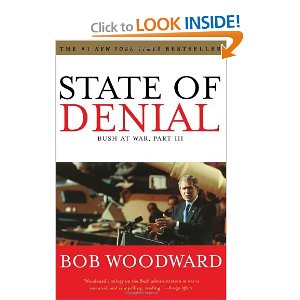
![]() You Can Read This More Than Once, and Learn Each Time
You Can Read This More Than Once, and Learn Each Time
July 22, 2007
Ralph Peters
Ralph Peters is one of a handful of individuals whose every work I must read. See some others I recommend at the end of this review. Ralph stands alone as a warrior-philosopher who actually walks the trail, reads the sign, and offers up ground truth.
This book is deep look at the nuances and the dangers of what he calls the wars of blood and faith. The introduction is superb, and frames the book by highlighting these core matters:
* Washington has forgotten how to think.
* The age of ideology is over. Ethnic identity will rule.
* Globalization has contradictory effects. Internet spreads hatred and dangerous knowledge (e.g. how to make an improvised explosive device).
* The post-colonial era has begun.
* Women's freedom is the defining issue of our time.
* There is no way to wage a bloodless war.
* The media can now determine the war's outcome. I don't agree with the author on everything, this is one such case. If the government does not lie, the cause is just, and the endeavor is effectively managed, We the People can be steadfast.
A couple of expansions. I recently posted a list of the top ten timeless books at the request of a Stanford '09, and i7 includes Philip Allott's The Health of Nations: Society and Law beyond the State. Deeper in the book the author has an item on Blood Borders, and it tallies perfectly with Allott's erudite view that the Treaty of Westphalia was a huge mistake–instead of creating artificial states (5000 distinct ethnic groups crammed into 189+ artificial political entities) we should have gone instead with Peoples and especially Indigenous Peoples whose lands and resources could not be stolen, only negotiated for peacefully. Had the USA not squandered a half trillion dollars and so many lives and so much good will, a global truth and reconciliation commission, combined with a free cell phone to every woman among the five billion poor (see next paragraph) could conceivably have achieved a peaceful reinvigoration of the planet with liberty and justice for peoples rather than power and wealth for a handful.
The author's views on the importance of women stem from decades of observation and are supported by Michael O'Hanlon's book, A Half Penny on the Federal Dollar: The Future of Development Aid, in which he documents that the single best return on investment for any dollar is in the education of women. They tend to be secular, appreciate sanitation and nutrition and moderation in all things. The men are more sober, responsible, and productive when their women are educated. THIS, not unilateral militarism, virtual colonialism, and predatory immoral capitalism, should be the heart of our foreign policy.
The book is organized into sections I was not expecting but that both make sense, and add to the whole. Part I is 17 short pieces addressing the Twenty-First Century Military. Here the author focuses on the strategic, lambastes Rumsfeld for not listening, and generally overlooks the fact that all our generals and admirals failed to be loyal to the Constitution and instead accepted illegal orders based on lies.
In Part II, Iraq and Its Neighbors, we have 24 pieces. The best piece by far in terms of provocative strategic value is “Blood Borders: How a Better Middle East Would Look.” Curiously he does not address Syria or Lebanon, but I expect he will since the Syrians just evacuated Lebanon and Syria and Iran appear to be planning for a pincer movement on Baghdad after they cut the ground supply line from Kuwait.
A handful of pieces, 5 in all, are grouped in Part III, The Home Front. The best two for me were “Our Strategic Intelligence Problem” in which he points out that more money and more technology are NOT going to make us smarter, it is humans with history, culture, language, and eyes on the target that will tease out the nuances no satellite can handle. He also points out how easily our satellites are deceived. I share his anguish in the piece on “Lynching the Marines.” I called and emailed the Colonel at HQMC in charge of the defense, and offered a heat stress defense that I had just learned about from a NASA engineer helping firefighters. If the body gets too hot, the brain starts to fry, and irrational behavior is the norm. The Colonel declined to acknowledge. That told me all I needed to know about how the Marines were all too eager to hang their own.
Part V was the most unfamiliar to me, covering Israel and Hezbollah. In 17 pieces, the author, an avowed supporter of Israel, pulls no punches, tarring and feathering the Israelis for being corrupt (selling off their military supplies on the black market (to whom, one wonders, since the only people in the market are terrorists?) confident the US will resupply them) and militarily and politically incompetent. To which I would add economically stupid and morally challenged–Stealing 50% of the water Israel uses to do farming that is under 5% of the GDP is both nuts and short-sighted. See the brief by Chuck Spinney at OSS.Net.
Part V, The World Beyond, is a philosophical tour of the horizon, from water wars and plagues (see my lists for books on each of the ten threats, twelve policies, and eight challengers), to precision knifing of Russia, France, and Europe. Darfur, one of over 15 genocides being ignored right now (Darfur because Sudan pretends to be helping on terrorism and the US does not have the will or the means to be effective there) is touched on.
The book ends marvelously with a piece on “The Return of the Tribes,” a piece that emphasizes the role of religion and the exclusivity of cults and specific localized tribes. They don't want to be integrated nor do they want new members.
Robert Young Pelton's The World's Most Dangerous Places: 5th Edition (Robert Young Pelton the World's Most Dangerous Places)
Sleeping with the Devil: How Washington Sold Our Soul for Saudi Crude
Deliver Us from Evil: Peacekeepers, Warlords and a World of Endless Conflict
Legacy of Ashes: The History of the CIA
The Sorrows of Empire: Militarism, Secrecy, and the End of the Republic (The American Empire Project)
The Fifty-Year Wound: How America's Cold War Victory Has Shaped Our World
Resource Wars: The New Landscape of Global Conflict With a New Introduction by the Author
Failed States: The Abuse of Power and the Assault on Democracy










